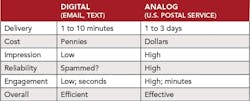A Low-Tech Secret to Help Home Builders Stay Competitive
Tina collapsed onto the sofa as John put the newest set of brochures and floor plans on the coffee table. “I used to think we were lucky to have so many new-home builders to choose from for our first home,” she said with a sigh. “Now I’m not so sure.”
“I know what you mean,” John replied. “Here we are with a down payment, able to buy any one of six different homes in good areas, but after three weekends of looking, they all feel like they’re starting to blend together.”
“I like at least four of the models enough to happily live in, but how can we tell which builder’s right for us?” Tina asked. “I’m more and more confused.”
“Do you remember how happy Mike and Amy were with Caring Builders and their personal service?” John asked. “I think we need to take another look at Caring Builders.”
“Let’s just take a break,” Tina said, “and not think about it for a couple of weeks!”
But John knew better: “I don’t think the 10 salespeople we’ve talked to are going to let us forget about it ...”
The Home Sales Process: Offering Something Different
John was right. In the next two days he and Tina received dozens of emails and text messages from the builders. One offered a free upgrade to granite kitchen countertops if Tina and John signed within a week. Another promised $5,000 off the home’s list price if the couple signed by the end of the month. “These robo-sales tactics make me feel like just an email address, not someone in search of a dream home,” Tina lamented.
After dinner one night, they started sorting through that day’s mail. “Look at this,” John said, “an actual handwritten note.”
The envelope from Caring Builders contained a handwritten note from Maria, the salesperson. She thanked John and Tina for coming to see the models and acknowledged their interest in a larger lot with mature trees. Maria identified five large lots and three with several mature trees. She wrote that she’d be happy to show them to Tina and John whenever the couple had time to look. Maria also provided her cellphone number so John and Tina could call her for an appointment.
“Wow,” John said. “Talk about paying attention. She even remembered our interest in a larger lot and some trees.”
“I like the personal note,” Tina added. “It makes me feel like we’re important to her.”
“Maybe this is why Mike and Amy are so happy with Caring Builders,” John answered. “Let’s take another look at their homes this weekend.”
Efficiency vs. Effectiveness in Home Builder Sales and Marketing
Where would your material fall in John and Tina’s pile of brochures, floor plans, follow-up, and communications? Discounts, free upgrades, and digital messaging are good support, but they all lack a personal touch. Technology enables the use of efficient methods, such as email and text messages, to stay in touch with potential and current clients, but it isn’t a replacement for more intimate customer engagement. To stand out from the pack, harness the power of analog: specifically, a personal, handwritten note (once a standard practice of good business).
In home building, there’s always the tension between efficiency and effectiveness. Preprogrammed email follow-up is efficient, but is it effective? Don’t get me wrong, a customer relationship management (CRM) system is very important. But as a company leader, I learned long ago that efficiency should be the benchmark for processes and systems, while effectiveness is best for people and relationships.
How many email messages do you receive per day? By 2018, many estimates say, the average will hit almost 100 emails per day per person. Of these, just 30 percent, on average, are actually opened, and once opened, an email gets about 10 to 15 seconds of attention before the recipient moves on to the next message. So even if your email communication is noticed and opened, you have a fraction of a minute to gain the person’s attention—not much engagement or relationship opportunity there.
For most of us, “snail mail” these days consists of the few bills that aren’t on automatic payment, charitable requests, direct-mail promotional materials, your monthly issue of Professional Builder magazine, and an occasional formal invitation. How many personal notes do you receive? If you’re like most, the answer is fewer than one per month. But receiving a stamped, handwritten note is an occasion. Snail mail comes from caring and conscientious people.
In the digital age, a personal touch has more impact than ever. By sending a handwritten note, you’re building a relationship before your potential customer even opens the envelope. Studies show that surface mail is still one of the most effective and appreciated means of communication. And, by the way, snail mail isn’t exactly glacial; local delivery averages one to three days. For the sake of engagement and impact, sometimes slower is faster.
Electronic Mail vs. Snail Mail for Customer CommunicationData culled by author Charlie Scott compares digital and analog modes of communication
Taking Care With Content: The Power of the Pen
The handwritten note that John and Tina received from Maria addressed something that was important to the couple: a larger lot and mature trees. Maria was paying attention. It’s worth noting that handwriting a form thank-you letter doesn’t put your team in a stronger position. It’s being personal that matters. Setting a policy of handwritten follow-up requires hiring salespeople who really listen. Notes should be written on the same day as the visit, while those potential customers are still freshly in focus.
Top leaders such as Jack Welch, former chairman and CEO of General Electric, and Doug Conant, former CEO of Campbell Soup Co., regularly handwrote notes to their employees. Many other businesspeople have found that such notes have an impact that’s missing from simpler methods of communication. In an interview on the American Express small-business website, Kate McKeon, CEO of the consultancy Prepwise, says, “Email is too easy to ignore. Phone calls can be invasive and are more challenging to schedule for me. Letters are hard to ignore and less invasive.”
The pen has power after homeowners move in, too. Our company offers paper surveys via the postal service (to our knowledge, we’re one of the few customer satisfaction research firms that still does so). There’s no question that a mailed survey is less efficient and there’s considerable cost involved in preparation, envelopes, postage, and return envelopes compared with the cost of conducting an email survey. Consequently, the practice has been dropped by many for the sake of efficiency and cost.
Instead, we let the customer decide on the response medium (postal service, online link, or phone call). Guess what the preferred medium is? In all age groups, the U.S. Postal Service wins. The mail version sends the message that the builder really cares about customer feedback and is actually going to read the customer’s responses. This, in turn, elicits more customer comments. The mail version offers more privacy, too.
Best Practices for Communicating With Prospective Homebuyers
To ensure that all of your communication to prospective buyers packs maximum effectiveness, here are some steps to get started.
• Have a planned engagement strategy. Be sure your team has a good understanding of how to effectively communicate with prospects and customers at every stage of the process.
• Be strategic with all forms of communication. That includes digital. Sometimes an email or phone call is the right contact decision. Sending routine notices of construction progress or confirmation contacts via email is using the right medium.
• Implement regular high-touch communication. Personal notes, cards, and letters, and face-to-face contact have emotional resonance.
• Stay engaged throughout the customer life cycle from prospect to homeowner.
• Share the love. What’s good for customers is good for everyone. A handwritten note of appreciation can make a huge difference for fellow staff members and trade partners, too.
• Provide options for customer feedback surveys—phone, internet, or paper.
Criteria for a personalized communication plan need to include effectiveness and engagement. The plan should match your company’s brand promise: If you say you’ll deliver a great homebuying experience, attention to customer care and personal touches must dovetail with that promise.
Coupled With Actions, Words Speak Louder
My firm’s founding partner, Keith O’Brien, once met Herb Kelleher, co-founder of Southwest Airlines, on a Southwest flight. “We talked for maybe three minutes as he was walking up and down the aisles chatting up the folks,” Keith recalls. “I lobbied for Southwest Airlines to add flight service to Minneapolis/St. Paul to compete with the high fares of its competitor. He told me that this was in the works, but a ways out.”
When Keith returned to the office from that trip, waiting for him was a handwritten, personal note from Kelleher thanking him for being a customer and recounting details of their conversation. “Herb made me feel special,” Keith recalls. “While this was over 20 years ago, I remember the note like it was yesterday.”
The chance meeting is a reminder that builders can learn from those in a wide variety of industries. What’s more, Keith considers the encounter an important lesson: People may not remember what you say, but they will always remember how you made them feel.


